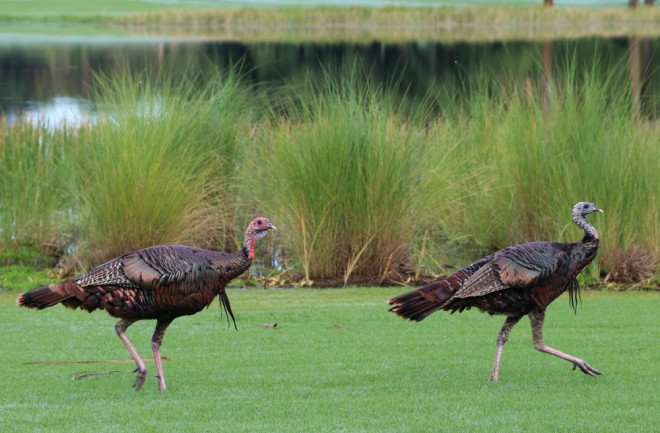Walking is perhaps one of the most difficult maneuvers a living creature can perform. And turkeys have highly evolved muscular and skeletal systems that support an efficient mode of locomotion: the trot.
Standing still, a turkey is in a state of stable equilibrium. Its center of gravity rests directly over its feet, with its muscles anchored to its skeleton, directing the turkey’s weight down below. While the turkey requires a small amount of energy to remain in balance, this is an efficient, low-energy posture.
But efficient, low-energy, stationary postures aren’t all that great for doing all the things a turkey likes to do, like searching for food, pecking at rivals, and escaping from predators. Doing any of these requires locomotion, which is a surprisingly complex and tricky task.
How Does a Turkey Trot?
To achieve movement, the turkey must first pitch itself forward, sending its center of mass in front of its feet. To prevent itself from falling, the turkey then must balance itself on one foot while simultaneously swinging the other leg forward.
While it looks like a turkey has a backwards-bending knee, what we see above its foot is actually its ankle (much like a cat’s ankle is placed high above its feet). The knee is tucked up in the feathers out of sight and articulates the same way a human knee does. Like many other animals, with this kind of joint arrangement, turkeys run on their forefeet (the equivalent of their toes). The turkey then catches its weight on the front leg, brings its center of mass forward, and repeats the process on the other side.
Read More: Turkey Trivia: 6 Fun Facts About Turkey
Does a Turkey Waddle?
Similarly to many other birds like penguins, turkeys do waddle when they walk, characterized by a slight side-to-side swing. While the exact purpose of waddling is not entirely understood, it’s believed that the waddle is a byproduct of the general concept of “biological conservation of energy.” This means that, all else being equal, animals choose their mode of locomotion to minimize the amount of energy expenditure.
This is one of the reasons that humans switch from walking to running at a certain speed – it becomes more energy efficient to fly both feet off the ground at higher speeds. With turkeys, the waddle may act as a pendulum that recovers some of the potential energy (from the change in position of its center of mass) and uses that for kinetic energy to propel it forward. Or, the waddle may serve to simply stabilize the turkey’s gait, which is another way of conserving energy, allowing the bird to smoothly and efficiently move from step to step.
Read More: The Ancient Art of Raising Turkeys
Why Does a Turkey Bob Its Head?
Another characteristic of the turkey trot is the distinctive head bobbing while walking. Common to all birds, turkeys do not have muscles that can control the positions of their eyes. Instead, they must rely on head movements alone.
The head bobbing allows the turkey to maintain a stable field of view, with only brief interruptions, while maintaining locomotion. Humans do a form of head bobbing too, but in a completely different content. When spinning around, it’s best to maintain gaze on a fixed object until your neck can no longer sustain the twist, at which point you whip your head around to fix on the same object. This is just head bobbing, but in a circle.
Read More: Should the Turkey Replace the Bald Eagle as the National Bird? Ben Franklin Thought So
How Do Turkeys Run?
Speaking of the trot, turkeys always keep at least one foot on the ground when walking or running, even at high speed. They don’t run the same way we do, by lifting both feet off the ground. It’s awkward, and energetically expensive, for humans to maintain that kind of gait, but for the turkey it’s natural, comfortable, and efficient.
Unfortunately, most of our images of turkey locomotion come from factory farms, where the turkeys have been selectively bred to have as much three times the breast meat of their wild cousins. Researchers have found that this increase in mass, without a proportional increase in bone structure or limb articulation, leads to a more comical looking gait. Domestic turkeys must pitch their bodies forward to stabilize themselves, keep their feet wider apart, take shorter, shuffling steps, and have a more pronounced waddle. In contrast, wild turkeys are much more streamlined and efficient in both their posture and their movement.
And when turkeys are done trotting, for example if they get spooked, they also have the option of opening up their wings to fly – up to 60 miles per hour!
Read More: Turkeys Are Capable of "Virgin Birth"

